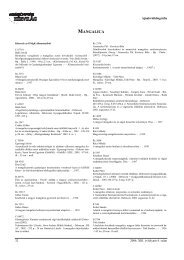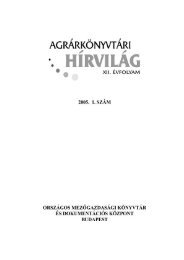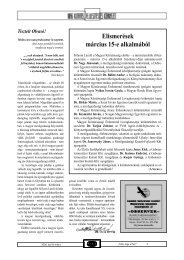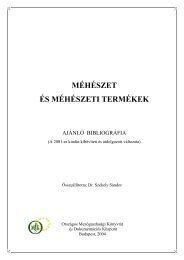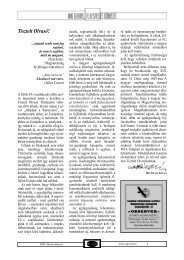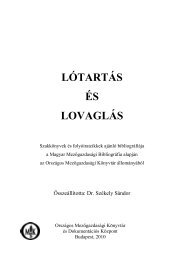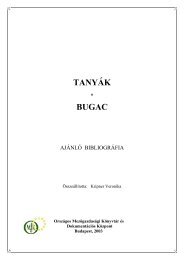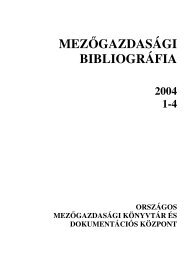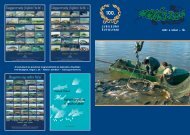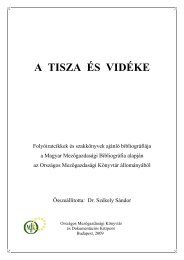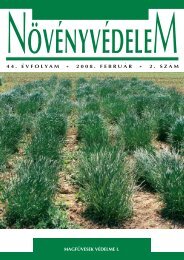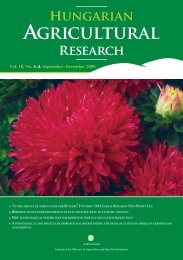2009/9. - Országos MezÅgazdasági Könyvtár
2009/9. - Országos MezÅgazdasági Könyvtár
2009/9. - Országos MezÅgazdasági Könyvtár
You also want an ePaper? Increase the reach of your titles
YUMPU automatically turns print PDFs into web optimized ePapers that Google loves.
504 NÖVÉNYVÉDELEM 45 (9), <strong>2009</strong><br />
G. (2004): Assessment of the performance of the<br />
Ames II assay: A collaborative study with 19 coded<br />
compounds. Mutation Res., 558: 181–197.<br />
Kaya, B., Creus, A., Velázquez, A., Yanikoğlu, A. and<br />
Marcos, R. (2002): Genotoxicity is modulated by<br />
ascorbic acid. Studies using the wing spot test in<br />
Drosophila. Mutation Res., 520: 93–101.<br />
Kirkland, D. J., Henderson, L., Marzin, D., Müller, L.,<br />
Parry, J. M., Speit, G., Tweats, D. J. and<br />
Williams G. M. (2005): Testing strategies in<br />
mutagenicity and genetic toxicology: An appraisal<br />
of the guidelines of the European Scientific<br />
Committee for Cosmetics and Non-Food Products<br />
for the evaluation of hair dyes. Mutation Res. /<br />
Genetic Toxicology and Environmental Mutagenesis,<br />
588: 88–105.<br />
Kwan, K. K. and Dutka, B. J. (1990): Simple two-step<br />
sediment extraction procedure for use in<br />
genotoxicity and toxicity bioassays. Toxicitv<br />
Assessment, 5: 395–404.<br />
Legault, R., Blaise, C., Rokosh, D. and Chong-Kit, R.<br />
(1994): Comparative assessment of the SOS<br />
chromotest kit and the Mutatox test with the<br />
Salmonella plate incorporation (Ames test) and<br />
fluctuation tests for screening genotoxic agents.<br />
Environ. Toxicol. Water, 9: 45–57.<br />
Quillardet, P. and Hofnung, M. (1993): The SOS<br />
chromotest: a review. Mutat. Res., 297: 235–27<strong>9.</strong><br />
Rédei P. Gy. (1987): Genetika. Mezôgazdasági Kiadó –<br />
Gondolat, Budapest<br />
Szabad, J., Soós, I., Polgár, Gy. and Héjja, Gy. (1983):<br />
Testing the mutagenicity of malondialdehyde and<br />
formaldehyde by the Drosophila mosaic and the<br />
sex-linked recessive lethal tests, Mutation Res.,113:<br />
117–133.<br />
Szabad J. (1987): Rákkeltô tényezôk szûrése muslica mozaikokkal.<br />
Tudomány, 2: 51–56.<br />
Szabad J. (2006a): A mutagenitás alapjai. 143–157. In:<br />
Darvas B. és Székács A. (eds.): Mezôgazdasági<br />
ökotoxikológia. l’Harmattan, Budapest<br />
Szabad J. (2006b): A daganatképzôdés molekuláris biológiája.<br />
170–178. In: Darvas B. és Székács A. (eds.):<br />
Mezôgazdasági ökotoxikológia. l’Harmattan,<br />
Budapest<br />
Waters, M., Stack, F., Jackson, M., Lohman, P., Lohman,<br />
W. and Rice, J. (2000): Genetic activity profiles of<br />
short-term tests with data from the US EPA and the<br />
IARC Monographs (GAP2000 programme)<br />
White, P. A. and Claxton L. D. (2004): Mutagens in<br />
contaminated soil: a review. Mutation Res., 567:<br />
227–345.<br />
Zeiger, E. (2001): Mutagens that are not carcinogens: faulty<br />
theory or faulty tests? Mutation Res., 31: 29–38.<br />
Zeiger, E. (2003): Illusion of safety: Antimutagens can be<br />
mutagens, and anticarcinogens can be carcinogens.<br />
Mutation Res., 543: 191–194.<br />
MUTAGENICITY TESTS AND MUTAGENIC SIDE-EFFECTS OF CERTAIN PESTICIDES<br />
Katalin Bokán, 1,2 Ágnes Fejes, 2,3 István Soós, 4 Gábor Fekete 1,2 and Béla Darvas 1,2<br />
1 Szent István University and Department of Ecotoxicology of Plant Protection Institute, Gödöllô-Budapest<br />
2 Department of Ecotoxicology and Environmental Chemistry, Plant Protection Institute, Hungarian Academy of Sciences,<br />
Budapest<br />
3 Eötvös Loránd University, Faculty of Science, Budapest<br />
4 Szent István University, Faculty of Pedagogy, Institute of Science and Health Education, Szarvas<br />
It is estimated that there are approximately a hundred thousand types of synthetic chemicals and<br />
many millions natural compounds present as components of Earth. Living organisms are being<br />
exposed to these natural and industrial chemicals through food, water and air. It is proven that eighty<br />
percent of all cancerous diseases are caused by mutagen contamination. The connection between<br />
carcinogenic and mutagenic compounds are strong, therefore, it is highly necessary for us to be able<br />
to detect the mutagenic effects of the agricultural chemicals. The three levels of mutation (gene<br />
mutation, clastogenecity and aneuploidy) should be covered in a limited number of tests. In case of<br />
a positive in vitro test, the potentially mutagenic substance should be studied in vivo in order to<br />
determine whether the in vitro genotoxic potential is expressed in vivo. Eighteen percent of all<br />
currently known chemicals, which display mutagenic effects during at least one test, are pesticides.<br />
Érkezett: <strong>2009</strong>. április 1.



